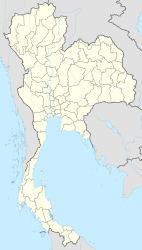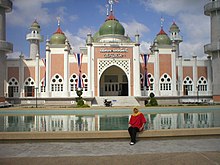Pattani
|
ปัตตานี Pattani |
||
|---|---|---|
|
|
||
| Coordinates | 6 ° 50 ′ N , 101 ° 20 ′ E | |
| Symbols | ||
|
||
| Basic data | ||
| Country | Thailand | |
| Pattani | ||
| ISO 3166-2 | TH-94 | |
| Residents | 43,809 (2012) | |
Pattani ( Thai ปัตตานี ; Malay Patani; Jawi : ڤتنا) is the capital of the Pattani Province in the southern region of Thailand . It is located on the Gulf of Thailand in the district ( Amphoe ) Mueang Pattani . Since 1935 it has had the administrative status of a “city municipality” ( Thesaban Mueang ) . In 2012, Pattani had 43,809 residents.
From the 14th or 15th centuries until 1808, Pattani was the capital of the Malay Sultanate of Patani , which was dependent on Siam for most of its history but was not an immediate part of it. Pattani was an important trading city and an important intellectual center in the Malay region until the 19th century. It was not until 1906 that the local rulers were ousted and Pattani finally became part of the Thai central state. To this day it is the cultural and religious center of the Muslim Malay in southern Thailand .
location
Pattani is located at the mouth of the Mae Nam Pattani (Pattani River) in the Gulf of Thailand in the middle of a fertile basin in the outer south of Thailand. It is about 1050 kilometers away from the capital Bangkok . The coast is idyllic and offers a very beautiful scenery. The hinterland is dominated by the foothills of the Tenasserim Mountains .
Economy and Transport
Pattani has a train station on the Southern Railway , which connects Bangkok with Malaysia .
The trading center is practically of no importance today, the port is silted up and can only be used for coastal traffic.
history
Pattani has been known as a trading center for over a millennium. Since the first acquaintance with the Europeans (1509 with the Portuguese ), Pattani, which early German-speaking travelers made known in their homeland as the “Kingdom of Pattana” or “Kingdom of Bethany”, has been a hub for goods to and from Europe. Goods were also exchanged with India and China. Pattani has been Islamized since the 15th century at the latest. The rulers were Rajas , who mostly recognize the sovereignty of more powerful neighboring states ( Srivijaya , Malacca , Johor and Ayutthaya ). The rulers of Pattani repeatedly refused to pay the tribute and tried to make themselves independent.
From 1516 there was a Portuguese trading post in Pattani, and Japanese, Chinese, Indian, Persian and Arab traders also settled here. The Dutch East India Company founded a trading post in 1602, followed by the British East India Company in 1611 . In 1619 a skirmish between Dutch and English warships took place in the bay off Pattani, from which the English emerged victorious.
In 1808, the Siamese King Rama I (Phra Phutthayotfa) divided the Sultanate of Pattani into seven principalities, which were still ruled by local Malay aristocrats, but increasingly exposed to the great influence of central power in Bangkok. Under King Rama V (Chulalongkorn), Pattani became the capital of a province in 1905/06 and the administrative seat of a Monthon (large administrative unit from several provinces), which was overseen by a representative of the central government.
During the Second World War , at the beginning of the Pacific War , Pattani was one of the main landing sites for the Japanese to conquer the Malay Peninsula . They landed their troops at dawn on December 8, 1941, without any resistance worth mentioning, and from here they advanced on to British Malaya .
See also History of Thailand .
Attractions
- Central Mosque - largest mosque in Thailand with an onion dome, is located on the outskirts.
- Fishing village - picturesque old facility at the mouth of Maenam Pattani in the Gulf of Thailand.
- Chao Maelim Kohnaeo Festival - second weekend in February, the climax is the run of devout Muslims over glowing coals.
- the unfinished Krue-Se mosque from the 18th century, 5 kilometers east of the city proper
literature
- Carl R. Wernhart: Christoph Carl Fernberger. The first Austrian globetrotter 1621–1628. Vienna 1972.
Web links
- City map of Pattani (names in English and Thai; last accessed October 5, 2015)
Individual evidence
- ↑ รายงาน สถิติ จำนวน ประชากร และ บ้าน ราย จังหวัด ราย อำเภอ และ ราย ตำบล ณ เดือน ธันวาคม พ.ศ. 2555 , DOPA.
- ^ Volker Grabowsky : Brief history of Thailand. CH Beck, Munich 2010, ISBN 978-3-406-60129-3 , p. 94.



